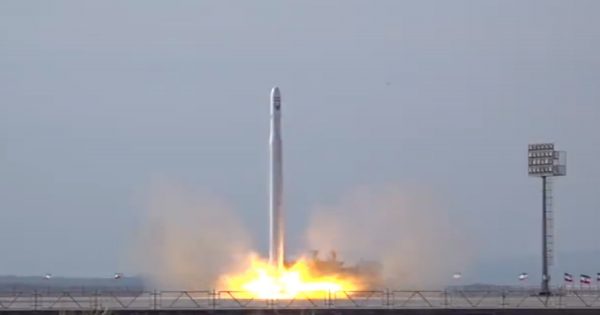Iran places military satellite in orbit – Spaceflight Now

Iran’s Revolutionary Guard Corps — a branch of the country’s armed forces — launched a small military spacecraft into orbit Wednesday, ending a string of rocket failures in the nascent Iranian satellite program.
The small military craft, named Noor, flew into orbit on top of a multi-stage Qased rocket, according to Iranian state media.
Iranian officials did not release any advance notice of the launch, which occurred from the Shahroud missile range in the northeastern part of the country.
Videos released by Iranian state media showed the Qased rocket lifting off from a mobile transporter, erector and launch vehicle at the Shahroud site. Little is known about the Qased, which means “messenger” in Persian, but the first stage of the launcher appeared to be liquid-fueled. The rocket’s upper stage may be solid-fueled, according to analysts who have examined the launch video.
This video is overloaded with information, including visuals of separation of the stages 1/2, ignition of 2nd stage and more. A treat pic.twitter.com/F2CVbjz6OR
— Tal Inbar (@inbarspace) April 22, 2020
The Noor satellite was deployed into orbit after the Qased rocket flew southeast from the Shahroud base, Iranian officials said. Iran released no information about the design or purpose of Noor, which means “light” in Persian, but the spacecraft was expected to be relatively small due to the modest size of the Qased launcher.
The U.S. military Wednesday was tracking two objects in orbit associated with the Iranian launch. The publicly-available orbital tracking data appeared to confirm Iranian claims that the launch was a success.
The objects — presumably the Noor satellite and the Qased rocket’s upper stage — were circling Earth in near-circular orbits around 270 miles, or 430 kilometers, in altitude. The orbits were inclined 59.8 degrees to the equator.
Wednesday’s mission was the first successful satellite launch by Iran since February 2015, but it was the first by the previously-unknown Qased launch vehicle. Iran’s previous satellite launch attempts used Safir and Simorgh rockets, which the country claimed pursued peaceful purposes.
The launch Wednesday showed Iran was apparently developing a secret military space program. The satellite launch was the first performed by Iran’s Revolutionary Guard Corps, or IRGC, a branch of the Iranian armed forces.
U.S. Secretary of State Mike Pompeo condemned Wednesday’s launch.
“The Iranians have consistently said that these missile programs were disconnected from their military, that these were purely commercial enterprises,” Pompeo said during a press conference Wednesday. “I think today’s launch proves what we’ve been saying all along here in the United States: The IRGC, a designated terrorist organization, launched a missile today.”
Four straight Iranian launches had failed to place a satellite into orbit since 2017. That series of failures did not include an accident last August in which a Safir rocket appeared to explode during preparations on a launch pad at the Iranian spaceport.
In the aftermath of the explosion last August, President Donald Trump tweeted an image of the damaged launch pad, in which he denied U.S. involvement. The image was taken by a classified National Reconnaissance Office spy satellite.
Little is known publicly about the imaging capabilities of NRO surveillance satellites, but Trump’s tweet allowed comparisons between the image resolution of NRO spy satellites and commercial imaging platforms.
Iran’s satellite launch program has a mixed success record.
The country placed its first satellite into orbit in 2009, then performed successful satellite launches in 2011, 2012 and 2015, all using Safir rockets. All three orbital launch attempts using the larger Simorgh rocket have failed.
Email the author.
Follow Stephen Clark on Twitter: @StephenClark1.






